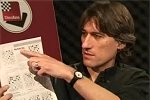


ChessBase 17 - Mega package - Edition 2024
It is the program of choice for anyone who loves the game and wants to know more about it. Start your personal success story with ChessBase and enjoy the game even more.
If GM Daniel King has ever put out a bad chess video or DVD, I have yet to see it. His superb mixture of instructional material, clear explanations, enthusiasm, a likeable personality/friendly conversational tone all combine to make him the #1 chess commentator in the business, in this writer’s opinion.
His latest effort, Power Play 10, is on one of the most important skills a chess player can possess: the ability to properly calculate. Coming up with a plan in a position is one thing—being able to successfully carry it out is another. There is nothing worse in chess than starting a combo and then realizing it has a huge hole in it, and then looking up and noticing that your opponent sees the refutation too. I mean, you just feel sick. And all it took was one overlooked check or other intermezzo, and suddenly your “winning idea” has just cost you the game.
And, of course, the higher up the chess ladder you go, the deeper and more accurate your opponent’s calculating powers become. How often have we heard, “And it was at this point I stopped my calculation, but my opponent had seen one move further and refuted my entire idea.” Your only recourse is to be sure you are constantly improving your own calculating ability so as not to fall behind. And GM King’s new DVD from Chessbase is really perfect for helping you do just this.
Let’s look at an example from the Introduction, which features a game between Kramnik-Anand, from their World Championship match in Bonn, in 2008:

White to Move: Is 1.Nxd4 a good move?
Can Kramnik safely capture Black’s dangerous passed pawn on d4, which is threatening to advance?
At first glance it appears the answer is No, since the pawn is attacked once (by the white knight on f3) and guarded once (by the black queen on f6). However, Kramnik saw a way to win back the material and obtain, what he thought, was a better position. Said King on the video, “I was watching this game… he cracked it off!” And so Kramnik did indeed take the pawn on d4. Anand captured the knight with his queen, and then Kramnik played rook d1. So from the above position, we have 1.Nxd4 Qxd4 2.Rd1:

Kramnik regains the piece via a skewer King explains that this was Kramnik’s idea, to win back material by skewering the knight on d7 with check. However, Anand had seen all this, and didn’t move his queen! Instead, he counter-attacked White’s queen with 2…Nf6. Now if White moves his queen, than Black is just up a piece since there is no longer a Knight on d7 to win back. So, Kramnik played 3.Rxd4 and Anand played 3…Nxg4, and Kramnik followed through with his idea and played 4.Rd7+:

Kramnik follows through with his idea to win back the piece Black moved his King out of check with 4…Kf6, and White regained his piece with 5.Rxb7. Anand now played 5…Rc1+ and Kramnik responded with 6.Bf1, retreating his bishop to the f1 square to block the check. Here King suggests that this is where Kramnik’s analysis had probably ended. But Anand had seen deeper and hit Kramnik with the beautiful 6…Ne3!!:

Apparently Kramnik had missed 6…Ne3!! And suddenly it’s all over! Checkmate is threatened and after 7.fxe3 fxe3, the e-pawn will become a queen - 0-1 for Black, who saw deeper
Now if this DVD just consisted of King taking the viewer through positions where one side had simply out calculated the other, it would be instructive, but nothing special.
However, here is where GM King goes the extra-mile. In the second half of the Introduction video clip, Daniel pulls out a German chess magazine and states that he is going to show you 5 different positions that you are to study, on a real chess board, and come up with the winning moves/plan for the side to move:

GM King displays the German Chess magazine that contains the puzzles the viewer is to solve, but with a twist!
And now for the twist, and it’s something I have NEVER seen on any other DVD: King informs you that he himself has not looked at the solutions! That when you come back to the next segment, he is going to be looking at each position, and trying to solve it, for the very first time! Thus, you get to see a Grandmaster think out loud, as he breaks down a chess position. To me, this is pure gold and something I think all improving chess players will want to see.
Click here for replay the start of the intro to the new course.
I don’t know how he does it, but GM Daniel King’s Power Play series just keeps getting better and better. Power Play 10 (Calculation) runs 4½ hours and contains a whopping 49 video segments. What’s more, it covers a topic that frankly ALL chess players, including myself, could certainly improve upon. Do yourself a favor and order a copy… you won’t be disappointed.
Powerplay 1 - Mating Patterns
Powerplay 2 - Attacking the King
Powerplay 3 - Pawn Storm
Powerplay 4 - Start Right
Powerplay 5 - Pawns
Powerplay 6 - Pawns, Pieces & Plans
Powerplay
7 - Improve your Pieces
Powerplay 8 - Knights and Bishops
Powerplay 9 - Major Pieces vs. Minor Pieces